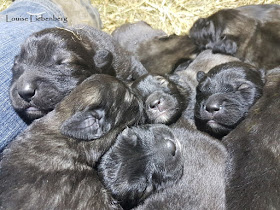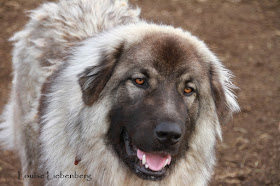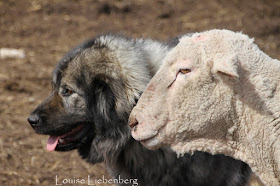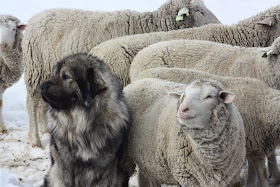
Being a good livestock guardian dog requires a balance of drives ( protective, nurturing and prey drive), too much of
the one or the other makes them unsuitable for this job.
Various breeds of livestock guardian dogs show variations in the amount of prey drive they typically display as young dogs.
Dogs with extremely high prey drive often do not show enough nurturing behaviour towards the stock, making them unsuitable to be good LGD, or, a dog with a high prey drive may have a really low protective instinct, making it unsuitable for this job.
The ideal livestock guardian dog will have balance of these traits to make it effective and efficient,and this of course will also be combined with physical traits that match those instincts.
Physically, a LGD needs to have the size, speed agility to be able to handle the rigorous working environment. They need good coats, strong bones and good conformation to last many years.
They need to be smart and alert.
In this blog, I just want to look at some of the genetic traits associated with LGD, the balancing act between a nurturing instinct, protective drive and prey drive.
True nurturing behaviour is something you rarely see in high drive dogs. They are highly motivated to do things ( think of your malinois, your sled dogs, all herding breeds and terrier breeds).
The dogs showing high nurturing qualities are generally regarded as your "softer dogs". However combine high nurturing, with high protective drive and you have a ranging momma bear on your hands.
Some LGD breeds show extremely high nurturing behaviour, however, if they do not have the combination with the protectiveness, then these dogs may not be bold enough to actually go out and protect the flock.
There is a difference between being bonded to the stock and showing highly nurturing behaviour. Being bonded to the stock ensures that the dog is happy and comfortable to always be in the vicinity of the stock, when the stock moves during grazing or to different pastures, the dog feels the need to move along with the flock. Bonding is where the dog and the sheep accept each others presence and the dog feels the need to protect the sheep. They should be protecting the stock and not the area the sheep are in, although these two do go hand in hand.
Bonding is not the same as nurturing.
Some dogs show very
little nurturing behaviour and act more as a territorial guardian dogs,
these may not be
as tight to the stock as many sheep keepers would like. Being a territorial livestock guardian dog is not an excuse for a poor LGD. Many livestock keepers feel nervous when the dog is not right in among the stock.
Not all livestock guardian dogs want to be really tight in with the stock, some prefer to lay further away, preferably on a hill side overlooking the grazing animals. Even with a more "territorial" type dog is must always be the stock that ties the dog to a certain area. A "territorial" dog is regarded as one who is more prone to patrolling and working from the outskirts of the flock than one who is closely bonded and laying right, tight smack, bang in the middle of the flock.
Some prey drive is
always evident in all dogs, it is just on a continuum. Herding
breeds are usually found on the high end of prey drive, ( allowing for them to be highly motivated to go and herd livestock) and most LGD are on the lower end of
prey drive.
A sheep running off triggers a border collie to head the
sheep, and herd it back. It is THE driving instinct behind herding.
In a LGD you actually do not want this response in the
dog, you do not want the LGD to be “triggered” when the lambs or goats
play or bounce around. A border collie (high prey drive) is easily triggered by
movement while a good LGD is not stimulated to give chase to a young bouncy lamb.
Add into this mix of nurturing behaviour and prey drive, is also a protective
drive.
Protective drive is the "meat and bones" of the job livestock guardian dogs do.
A dog who has no protective drive will not feel the need to respond to
threats to the flock or herd. You can
have a dog with a high nurturing capacity, low prey drive and low protective
drive, rendering this dog pretty useless when predators come calling.
To be effective, LGD need to be protective of their stock, of their pack and also to some degree their territory where the stock resides.
A LGD that misses the protective drive is IMO failing at its job.
It is always wonderful to have a sweet, kind dog in with the stock but if it is unable or unwilling to step into the gap when predators come calling, then in reality you do not have a livestock guardian/protection dog.
Not every dog has this perfect balance of traits, and that is okay. Different pack members compensate for these differences.
I know a few sheep keepers that really like to have a variety of breeds within
their guardian dog team in order to create a balance of these traits. Some
breeds are very mild in their protective traits and could use more “muscle”
breeds to beef up the whole protection level.
Having these various breeds help balance out the variations. In North
America it is possible to have access to these various breeds, however in many of the
countries where these breeds originate, the shepherds only have access to one
local“breed” and it is with that single “breed” that the shepherds need to
work with.
We run a single breed pack and have noticed how the dogs take on varying roles, some are close bonding type of dogs, others prefer a little more space, others are highly protective and some less so.
Running a larger pack of a LGD has made me see how
the dogs share and divide the various roles. Within the pack you will have the
dogs who tend to show more nurturing instinct, others will perhaps show more
protective drive, others patrolling and showing more territorial guarding
bahaviour. These rolls switch out and even as the dogs mature, they take on
different roles depending on various circumstances. Even during the same day the rolls are switched out.
The vast majority of owners tend to prefer
the dogs showing high nurturing instinct and tightly bonded to the sheep, preferably staying within the flock.
The
selection is often solely based on this “nurturing” trait with little consideration for the other traits.
Many people tend to forget
that the dog also needs to be protective and aggressive enough to withstand the
pressure placed on them, in areas with a high predator load.
Selecting for just
that one singular trait actually “weakens” the dogs, making the dog perhaps
less inclined to react to threats and certainly not bold enough to face
predators.
Breeding for softer and softer dogs makes the dogs themselves a
target for predators.
Having that ultra soft
dog, hanging out with lambs is of course heartwarming but if he cannot ward off
a predatory attack, then the dog is not really suitable for its job.

A dog who is bold enough to ward off big predators and is gutsy
enough to stand between the flock and the threat, is most often the dog that has
a high protective drive and perhaps a tad more prey drive. These dogs are often
a little harder to raise, and may be more challenging to handle. These
dogs may require a little more supervision, a few more corrections along the
way to becoming a great reliable adult. For many sheep farmers this may sound
like a disaster waiting to happen, however it is these dogs that allow you to
sleep easy, it is these dogs that will take the “proverbial bullet” when the
going gets tough.
In my opinion, a lot of the working LGD are getting bred to
be weaker and weaker. The selection on just one trait and
forgetting the need for the balance of these instincts, is perhaps a concern. The general consensus is that
you have harder and softer LGD breeds. However, historically, all the LGD should
be hard enough to handle the predators in their country and for the most part in Europe, and the America's the threats are wild canids.
Why are some breeds getting so soft that the USDA feels the need to try
and test more aggressive breeds of dogs in their government funded research?
Does the problem lie with the lack of breeding selection and not
enough attention paid to finding the balance of traits?
Is it because so many breeds are getting "watered" down due to crossbreeding?
Is it because people are scared to have to correct a slightly unruly pup, believing that it will never make the grade as a LGD?
I personally, do not mind a harder
dog, just because I may have to supervise it more as a young dog does not
necessarily mean it will be disqualified as a good LGD.
I know, I need some tough ones, those who will be willing to stand in the gap.
Correcting a young, strong willed dog for some naughty behaviour may be
necessary, but you sure as hell, cannot force a soft dog to go out and protect the herd when
trouble comes calling.
Understanding the difference and knowing which dog has a
problematic prey drive versus a strong willed protective drive, is key in knowing
which dog is going to make the grade and which is not.
I am a firm believer in the nature AND nurture theory, not nature versus
nurture. It is about the whole package, the dogs need to be bred with good
selection for the desirable traits, they need to be doing the job in order to be able to make the selection and those traits need to be nurtured in a
manner where the dog can truly excel at its job.





































